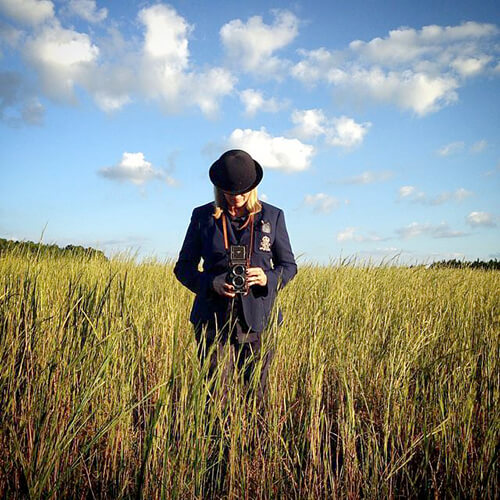After a career as a New York Fashion Editor and working along side the greats of fashion photography, Aline Smithson discovered the family Rolleiflex and never looked back. An artist now represented by galleries in the U.S. and Europe and published throughout the world, Aline continues to create her award-winning photography with humor, compassion, and a 50-year-old camera.
She has exhibited widely including solo shows at the Griffin Museum of Photography, the Center of Fine Art Photography, the Fort Collins Museum of Contemporary Art, the Lishui Festival in China, the Tagomago Gallery in Barcelona and Paris, and the Wallspace Gallery in Seattle and Santa Barbara. In addition, her work is held in a number of museum collections. Her photographs have been featured in publications including The New Yorker, PDN (cover), the PDN Photo Annual, Communication Arts Photo Annual, Eyemazing, Soura, Visura, Fraction, Artworks, Lenswork Extended, Shots, Pozytyw, Incandescant, Square and Silvershotz magazines. amongst others.
In 2012, Aline received the Rising Star Award through the Griffin Museum of Photography for her contributions to the photographic community. She also was presented with the 2014 Excellence in Teaching Award from CENTER. In 2014, Aline's photographs were selected for the Critical Mass Top 50, the PDN Photo Annual, and Review Santa Fe. In 2015, she was awarded First Place Portraiture in the 7th Edition of the Julia Margaret Cameron Awards for Women Photographers and again received the Julia Margaret Cameron Award in the 8th Edition.
Aline founded and writes the blogzine, Lenscratch, that celebrates a different contemporary photographer each day and offers opportunity for exhibition. She has been the Gallery Editor for Light Leaks Magazine, a contributing writer for Diffusion, Don't Take Pictures, Lucida, and F Stop Magazines, has written book reviews for photoeye, and has provided the forwards for artist's books by Tom Chambers, Flash Forward 12, Robert Rutoed, Nancy Baron, Meg Griffiths amongst others.
Aline has curated and jurored exhibitions for a number of galleries, organizations, and on-line magazines. She was an overall juror in 2012 for Review Santa Fe, a juror for Critical Mass from 2009-2016, a juror and curator for Flash Forward, and is a reviewer at many photo festivals across the United States. Aline is also a founding member of the Six Shooters collective. In the Fall of 2015, the Magenta Foundation released a retrospective monograph of Aline's photographs. She lives and works in Los Angeles and considers her children her greatest achievement.
Discover Aline Smithson's Interview
Find out more about Self & Others
